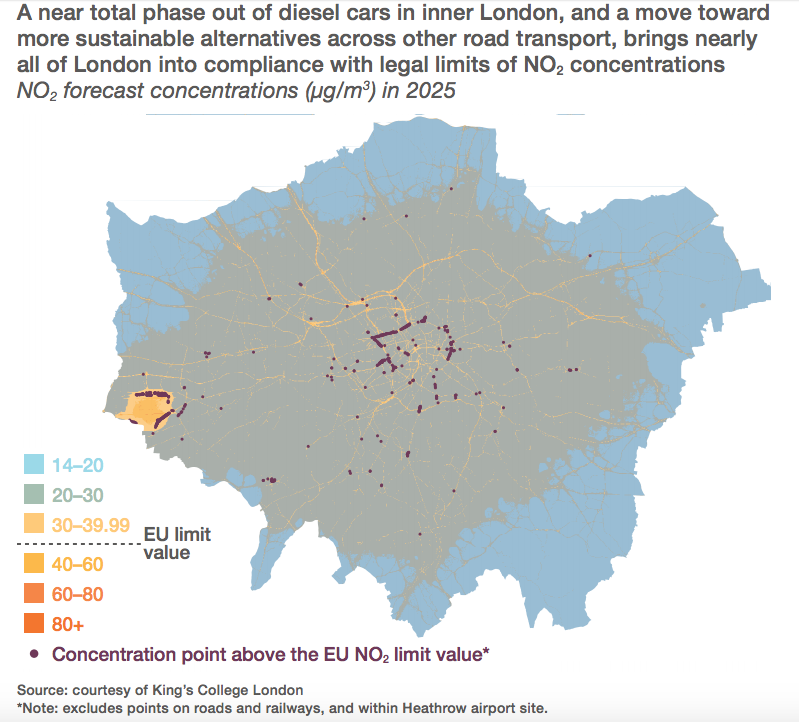
ClientEarth has won its High Court case against the Government over its failure to tackle illegal air pollution across the UK.
In a damning indictment of ministers’ inaction on killer air pollution, Mr Justice Garnham agreed with ClientEarth that the Environment Secretary had failed to take measures that would bring the UK into compliance with the law “as soon as possible” and said that ministers knew that over optimistic pollution modelling was being used.
In his ruling, the judge, who listened to two days of argument at the High Court last month, questioned Defra’s five year modelling; saying it was “inconsistent” with taking measures to improve pollution ” as soon as possible.”
Defra’s planned 2020 compliance for some cities, and 2025 for London, had been chosen because that was the date when ministers thought they’d face European Commission fines, not which they considered “as soon as possible.”
The case is the second the government has lost on its failure to clean up air pollution in two years.
In April 2015, ClientEarth won a Supreme Court ruling against the government which ordered ministers to come up with a plan to bring air pollution down within legal limits as soon as possible. Those plans were so poor that ClientEarth took the government back to the High Court in a Judicial Review.
In his judgment handed down this morning, Mr Justice Garnham ruled that the government’s 2015 Air Quality Plan failed to comply with the Supreme Court ruling or relevant EU Directives and said that the government had erred in law by fixing compliance dates based on over optimistic modelling of pollution levels.
ClientEarth CEO James Thornton said: “I am pleased that the judge agrees with us that the government could and should be doing more to deal with air pollution and protecting people’s health. That’s why we went to court.
“The time for legal action is over. This is an urgent public health crisis over which the Prime Minister must take personal control. I challenge Theresa May to take immediate action now to deal with illegal levels of pollution and prevent tens of thousands of additional early deaths in the UK. The High Court has ruled that more urgent action must be taken. Britain is watching and waiting, Prime Minister.”
During evidence, the court heard that Defra’s original plans for a more extensive network of Clean Air Zones in more than a dozen UK cities had been watered down, on cost grounds, to 5 in addition to London.
ClientEarth air quality lawyer Alan Andrews added: “We hope the new Government will finally get on with preparing a credible plan to resolve this issue once and for all. We look forward to working with Defra ministers on developing a new plan which makes a genuine attempt to achieve legal limits throughout the UK as soon as possible.
“We need a national network of clean air zones to be in place by 2018 in cities across the UK, not just in a handful of cities.The government also needs to stop these inaccurate Modelling forecasts. Future projections of compliance need to be based on what is really coming out of the exhausts of diesel cars when driving on the road, not just the results of discredited laboratory tests.”
http://www.clientearth.org/major-victory-health-uk-high-court-government-inaction-air-pollution/
.
Lethal and illegal: Solving London’s air pollution crisis
Wed 2 Nov 2016
Air pollution levels in London exceed legal and World Health Organisation (WHO) limits for NO2, and WHO limits for particulate matter. In 2010, for example, these pollutants caused a range of health problems in the capital that are estimated to have shortened lives by 140,743 years – the equivalent of up to 9,400 deaths, and representing an economic cost of up to £3.7 billion. Poor air quality in London is causing a public health problem of the highest order: air pollution is the second most significant factor in determining health, after smoking. If London is to continue to flourish and prosper as a global city it must tackle this air pollution crisis.
The principal driver of air pollution in London is road transport and, within that, diesel vehicles. Nearly 40 per cent of all NOx emissions within London come from diesel vehicles, and unless this is explicitly tackled it will be impossible to cleanse London’s air. New modelling by King’s College London commissioned for this report estimates that policies bringing the level of diesel cars in inner London down to 5 per cent of the fleet, and increasing cleaner alternatives across other vehicle types, would bring 99.96 per cent of London into compliance with legal levels on NO2. The central conclusion of this report is therefore that London must progressively phase-out diesel vehicles over the next decade and beyond in order to reduce air pollution levels down to legal and ultimately healthier levels.
This transition will take time, but there is much that the mayor can do now. This report presents a strategy for this mayoral term and the next.
Within the mayor’s current term, new policies to reduce air pollution should focus on increases in regulation and road charging, and tax reforms. Investment should then be channelled into sustainable alternatives, including shared transport, and support programmes for those groups most affected during the transition. Beyond 2020, our strategy recommends increases in the extent of road pricing in order to reduce the use of petrol vehicles and road miles.
These measures are likely to have a significant positive impact on London’s economy and carbon emissions, as well as on public health. Other global cities such as Paris, Berlin and Delhi are taking radical action to clean their air – it is time for London to do the same.
KEY FINDINGS
- London is breaking legal and WHO limits for NO2, and WHO limits for particulate matter. Under the existing policy regime the capital is not expected to reach compliance with the legal limits on NO2 until 2025 or beyond. No level of air pollution exposure is safe.
- Most air pollution in London is caused by road transport, of which diesel vehicles are the most polluting, emitting about 40 per cent of the capital’s total NOX emissions and a similar proportion for PM10. As such, many diesel vehicles will need to be progressively phased out in order to bring air pollution to within acceptable levels. In the near term, this means legal limits; in the longer run, it will mean reducing emissions down to negligible levels.
- Modelling undertaken by King’s College London for this report estimates that policies that would bring the levels of diesel cars down to 5 per cent in inner London, and drive a move towards cleaner alternatives across other vehicle types, would bring 99.96 per cent of London into compliance with legal levels on NO2.
- These improvements in air quality would result in an estimated gain of up to 1.4 million life-years over a lifetime across the population of Greater London, providing an estimated annualised economic benefit of up to £800 million (see the annex).
- Policies to achieve the reduction of air pollution to acceptable levels will impact millions of those who live, work and travel within and out of London, so significant investment is required in policies to support those groups most affected and to provide alternative and sustainable transport options. Policies must send clear messages to vehicle manufacturers, and the mayor will need to work in concert with other cities and central government.
- Policy at the London level needs to be complemented by action at a nation and European Union scale. Air pollution and road transport manufacture, use and ownership do not respect borders, while the UK’s departure from the EU means that legislation on air pollution limits could be repealed and standards reduced.
RECOMMENDATIONS FOR LONDON GOVERNMENT
Phase 1 (2016–2020)
- The mayor should extend the ultra low emissions zone (ULEZ) and accelerate its implementation, including by:
- extending the ULEZ up to the north and south circular roads, bringing implementation forward to 2019
- ensuring that diesel cars below the Euro 6 standard and petrol cars below the Euro 4 standard are charged a fee per day if they enter the zone
- increasing the pollution standard on LGVs within the LEZ so they must meet Euro 5, from the current requirement of Euro 3
- increasing the pollution standard on HGVs and coaches within the LEZ to Euro 6, from the current requirement of Euro 4
- Transport for London should procure only hybrid or zero emissions buses from 2018 and increase the emissions standard on TfL buses to Euro 6 within the expanded ULEZ.
- Central government should devolve vehicle excise duty to the London level.
- The mayor should require all newly licensed private hire vehicles to be zero-emissions capable from 2018.
- The mayor should call on central government to provide a diesel scrappage scheme.
- Transport for London should determine any temporary exemptions and discounts for those most adversely affected by the expanded ULEZ.
- The mayor should include a plan for the expansion of the car share market in his new transport strategy.
Phase 2 (2020–2025)
The mayor should:
- ensure that all Euro 6 diesel cars are charged within the expanded ULEZ by 2025, announce the plan to charge all diesel cars in the expanded ULEZ as soon as possible
- increase the pollution standard on LGVs within the LEZ so that they must meet Euro 6 by 2025
- ensure that all buses are zero emissions within central London, and on major routes where air pollution levels are particularly acute
- implement a ban on all diesel taxis across London in 2025
- introduce an emissions charge on all non-zero-emissions cars across inner London by 2025
- consider introducing a zero emission zone across central London from 2025
- mandate TfL to investigate the potential for a smart charging system and an integrated road pricing scheme in London
- ensure the revenues raised by road charging are reinvested into the public transport network and other alternative, sustainable transport options.
Other recommendations
Influencing EU policy
- The mayor should work with other city mayors around Europe to argue for implementation date of the conformity factors to be brought forward, eventually introducing a conformity factor of 1 by 2021.
National policy
The government should:
- introduce a new Clean Air Act that targets air pollution, including nitrogen oxides and particulate matter
- introduce a diesel scrappage scheme
- progressively reform the VED regime to disincentivise diesel cars relative to petrol.
The Department for Transport should:
- convene all relevant departments to ensure the transport analysis guidance accurately reflects the cost of air pollution within its appraisal process.
http://www.ippr.org/publications/lethal-and-illegal-solving-londons-air-pollution-crisis
.
.
The IPPR’s “60 second summary” of “Lethal and Illegal” is at
.
The full IPPR report (53 pages) of “Lethal and Illegal” is at
.
.
.
.
.
.

